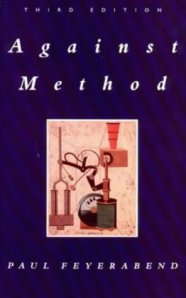You are currently browsing the monthly archive for September 2010.
With a bizarre feeling of witnessing the future, I have just read Malcolm Gladwell’s excellent piece in the New Yorker (dated 4/10/10!) on the problems that social networking will face in causing any social change. Over at Frontal Cortex, Jonah Lehrer has published an excellent reply challenging some of the claims Gladwell makes. This is a fascinating debate and a wonderful source of interesting distractions when you are meant to be working.
Any how, I want to take a different line and ask a related question about this. What do the differences between strong ties and weak ties imply for science communication? Read the rest of this entry »
The journey continues. After reading “What is this thing called science” by A. F. Chalmers, I got a rush of blood to the head and decided to take the plunge. It is fascinating stuff, and what is particularly interesting to me is that, as a geologist, I was born just after probably the most significant revolution in geology of all time – the plate tectonics revolution. It is an amazing story of the progress of science, one that should be told and analysed more (and if I have the time, I will!)
So now, the history and philosophy of science is firmly on my agenda. Here’s the recent additions:
The astute reader will note the lack of Lakatos here. My mistake, let me get through these three first…
Also, this may take me a while – lacking a formal education in philosophy, some of these folks can be quite obtruse… but you get there in the end…
When I was a child, I had what some might describe as an unhealthy obsession with TV documentaries about the world and wildlife. My tastes were not particularly discriminating, I would watch shows with a conservation theme, then enjoy a fishing show (I used to fish a lot with my Dad). But I loved watching shows that presented animals in their natural environment, and that gave us that little bit more knowledge about the world around us (one such series is actually called “The world around us”). I lapped up shows by the likes of David Attenborough and Ben Cropp.
Having exhausted what was on TV, I convinced my parents to take me to the video shop to get more. There I first discovered Malcolm Douglas; although he was already one of the highest rating documentary makers in Australian history. This khaki-clad adventurer would leap around the top half of our continent, handling snakes, chasing lizards, helping to catch and relocate troublesome crocodiles. He’d get bogged in his 4WD, then get out again competently (if a little muddy). The end of the day would be celebrated with a lesson on how to survive and flourish in the bush. Through Douglas’ lens I got to see parts of my country that I’d not seen before, and saw the behaviour of strange and dangerous creatures in their natural habitat. I was particularly impressed with his gentle skill with the animals he showed. As with his peers (though those like Douglas have few) he instilled in me a deep curiosity in the natural world, and more than that, a desire to learn more and pass it on to others. Read the rest of this entry »
Finally, I have a film to submit for UWA Science Communication! It is still to be submitted, but as soon as I am able I will get it out into the world.
In the meantime, here is the first 12 seconds!!
I thought I would comment on some lessons learned. This has been a great experience, and I hope to do more of this.
1. Write a good storyboard, but be prepared to ignore it. Get to know your talent’s work/background before you interview him/her. Revise the storyboard after having an intro discussion with your talent, and use it as a running sheet during your interview. Again, it still may go out the window in the editing.
2. Audio, Audio, AUDIO! Use good mics and watch for background noise. Its a killer. I used a decent shotgun mic and I still had noise problems. It just goes to show why professionals use lots of expensive gear (oh, if only uni provided…)
3. Get as much material from your talent as possible. Everything, stills, videos, random stuff. You never know how you can use it, and a good library of it is essential during editing. Read the rest of this entry »
At what point should a person move from explaining their scientific discoveries towards advocating their importance in policy development? And is science communication simply a form of advocacy itself? These are some of the thorny questions posed to Michael Nelson, associate professor of environmental ethics and philosophy at Michigan State University, in “Do Scientists Have a Special Responsibility to Engage in Political Advocacy?” by Matthew C. Nisbit.
In the interview, Nelson refers to his paper, co-authored with John Vucetich entitled “On Advocacy by Environmental Scientists: What, Whether, Why, and How” in which he finds that “advocacy is nearly unavoidable, and that scientists, by virtue of being citizens first and scientists second, have a responsibility to advocate to the best of their abilities, to improve their advocacy abilities, and to advocate in a justified and transparent manner.”
It is still not an easy question though. Really it boils down to what we are prepared to accept in society from our scientists. Read the rest of this entry »
Over at Science and The Media, the blog of my university class (of the same name), a small debate is going on about balance in science reporting (obviously hot button because of climate change).
ScientistMags stated in reply: “I think it’s time to balance out the scales of critique by highlighting good science journalism. It would also be an opportunity to demonstrate critical thinking in practice to people who normally do not think about the credibility of what they come across.”
I think this is a really good point that should be taken up. However, it brings up the hoary old MOP vs MOE debate. Measures of Performance in communication are relatively easy. We can objectively assess the number of good (basically correct and informative) media pieces versus the number of bad ones (sensationalised, wrong, misquoted, wrongly biased).
What are harder are Measures of Effectiveness. However, I suspect the risk of mis-educating the public through bad science is higher than the risk of no education at all from not reading good stories; that is to say, bad stories are probably more effective than good ones.
The highlighting of bad science sells books by the truckload, so we know that people are reading that. So, how do we measure the positive effect of good science (and science journalism) so that we can get out their and reinforce this work, and most importantly, measure its effectiveness?
In the coming month I will be producing a short film profile of Gary Cass, a scientific researcher in the soil science/agriculture section of the Faculty of Natural and Agricultural Sciences at the University of Western Australia where I am studying a Masters in Science Communication.
He is famous for the Red Wine Dress. He used to work in a vineyard and he noticed a thin film of slime that developed on red wine when Acetobacter infected it and turned it to vinegar (a wine-maker’s worst nightmare). Being an artistic person, he wondered whether it would be useful as a fabric. The film was in fact threads of nanofibre-scale cellulose that is the ‘poo’ of the bacteria. So he got together with an artist and developed the world’s first “Red Wine Dress”. As creative as that was, what he’s realised is that the same cellulose fabric is potentially useful in other applications. He’s now involved in further research into these materials.
The great thing is that all you need is wine, sugar and the bacteria to produce it. It can even be used to produce biofuels. In other words, we could have a multi-use biofuel technology – wine, fabric and fuel all from the one crop. It’s far more land efficient than sugar cane for instance. The spooky part is what a colleague of his is doing in the States – he’s taken gene’s from the Acetobacter and put them in cyanobacteria, so now these little bugs photosynthesise to produce the same cellulose. All they need is water, sunshine and carbon dioxide!
I spoke to him yesterday and he is passionate about creativity in science. One of the things he does is teaching at a school here, Shenton College. It’s a program he developed where he gets the kids (year 11s) to learn earth history, biology and genetics using artistic methods. So for instance, one kid coded a musical score from his basic DNA sequence. Another group of girls put the process of abiogenesis to dance! The reaction has been very positive and he’s now getting international attention for his approach. He thinks that creativity is an essential part of scientific progress (really shouldn’t come as a shock to anyone, that, but it does challenge traditional ideas) and that for too long science education has stifled that. Art is a natural medium to reintroduce it, and the strong boundary between art and science has been unnecessarily created. He struggles somewhat with the question of whether he’s an artist or a scientist! He did agree however, that really it’s depends on the work he’s doing – when testing hypotheses, he’s a scientist, when developing creative ideas, he’s more of an artist.
My film will be a profile of him with a focus on the Shenton college program, with some background about the red wine dress.
A few links about him:
http://www.news.uwa.edu.au/business-briefing/grow-your-own-dress-uwa
and here’s a little film about an exhibition with him: http://www.youtube.com/watch?v=f-F2RD1KZT4
his website: http://bioalloy.org/o/ and particularly the dresses: http://bioalloy.org/o/projects/micro-be.html and the evolution pages: http://bioalloy.org/o/projects/bioalloyevolution.html
I am interested in the information that is lost as scientists proceed from experiment to publication. The real factors that slip through the cracks of expediency. What is more important in the communication of research, the method, or the factoid results that come from it? Are we too trusting in the scientific method? Has peer-review become a substitute for a wider interrogation of method?
These are just a few questions going through my mind as I read “Simplification in Scientific Work: An Example from Neuroscience Research” – a 1983 article by the late Susan Leigh Star. I was particularly struck by an early observation in the article that “published scientific conclusions tend to present results as faits acomplis, without mention of production of decision-making processes.” I am not sure that this is so true today, but I am intrigued by the possibility that it is exactly that loss of information (as research is presented with a higher degree of ‘granualrity’) that opens a door for skepticism in the wider community. When a large body of research by multiple scientific schools tends to agree on a matter, there is sometimes an impression given that they are all doing exactly the same experiments. Whilst the broad methods are the same, of course expedient decisions are made and this causes subtle differences. These are not always thoroughly explained, even if they are justified. I can’t help but think that something in this is relevant to the skeptical program in climate change. Is this what lets in the calls of “conspiracy”?
More to read, more to do. I have a few other things on my plate, but this is an intriguing line of research.




